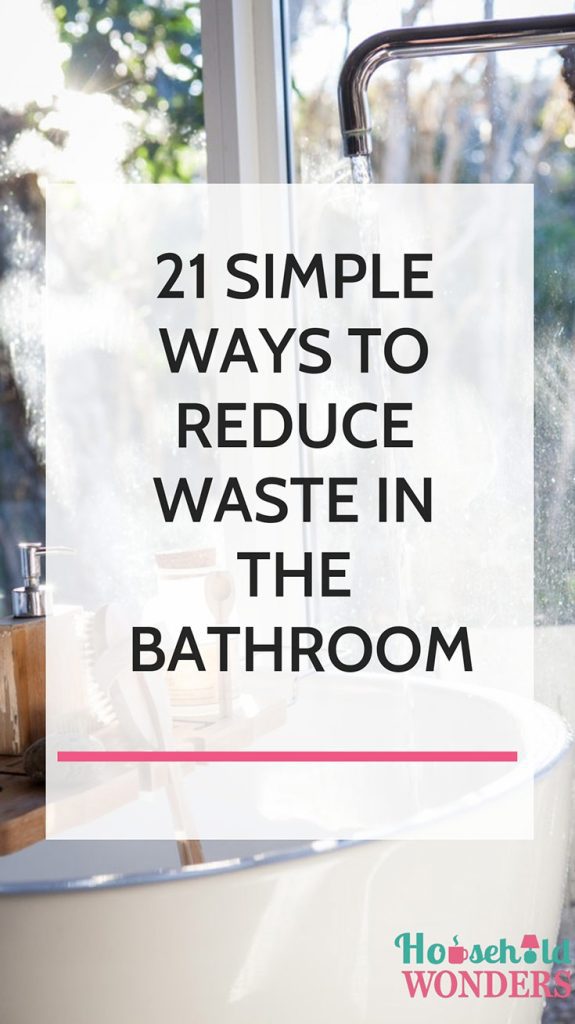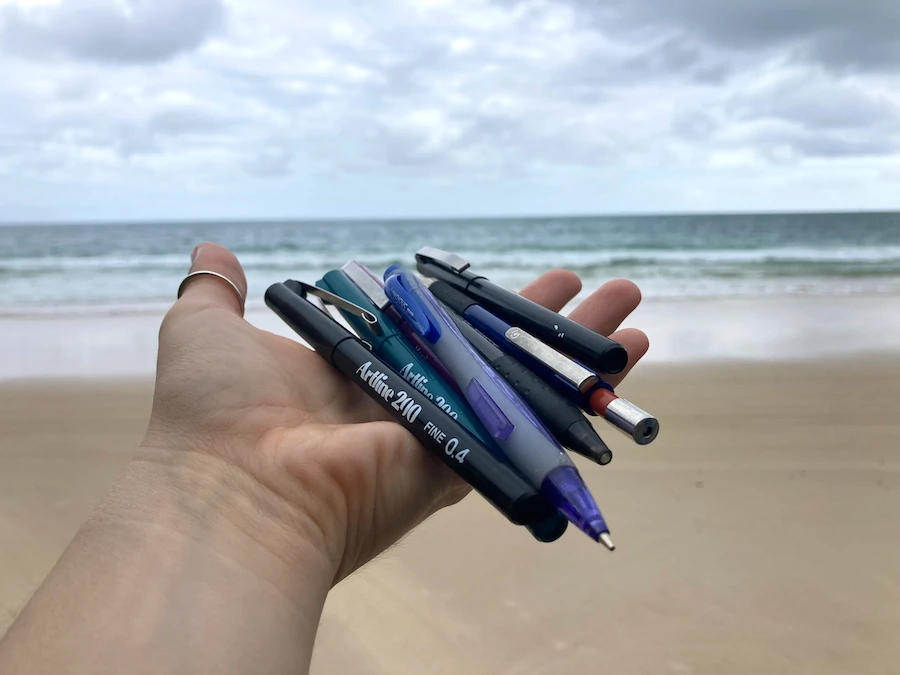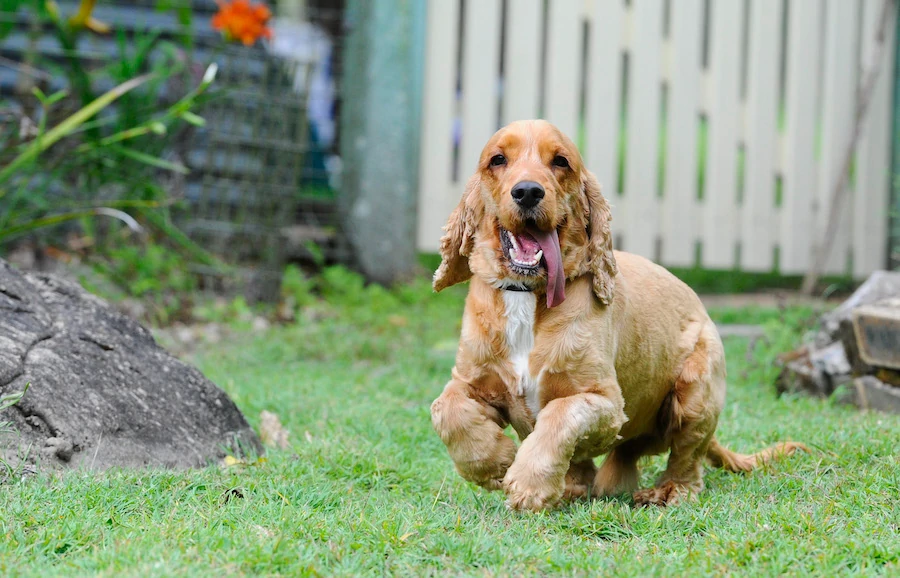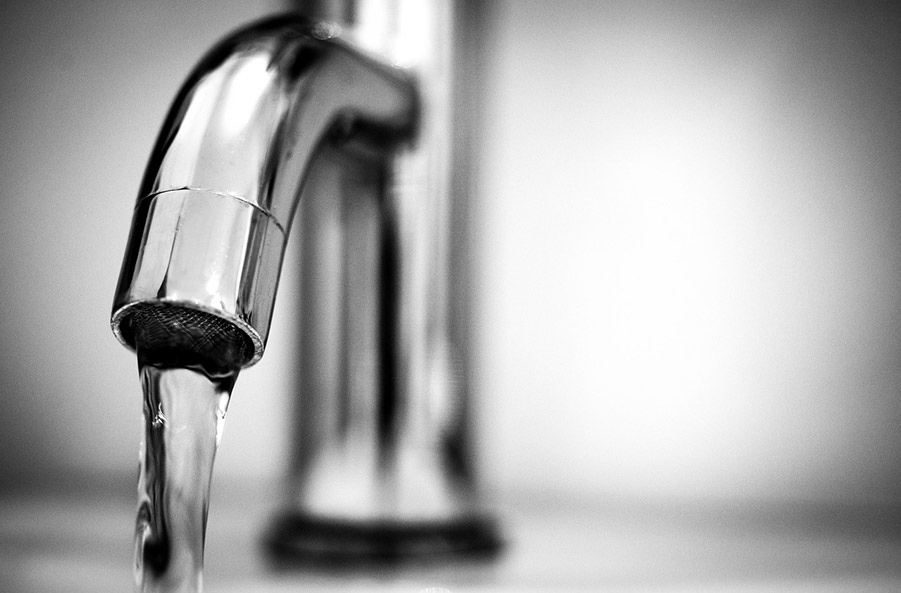
If you are like me, you want to reduce waste throughout the entire home. I evaluated my beauty, personal care, and hygiene routines and found out I was producing more waste in the bathroom than anywhere else in the house.
You can find dozens of solutions, however, some are more complicated than others and not so easy to start. I’ve done some homework and personally tried out some simple ways to reduce waste in the bathroom.
So what are some simple ways you can reduce waste in the bathroom?
21 Simple Ways to Reduce Waste in the Bathroom
1. Declutter and Purge
This may come as obvious but the fewer products you have in your bathroom, the less waste you will produce! Make an effort to reorganize all of your cosmetics, toiletries, and hygiene products so they are easy to find and reach. Get rid of the ones you do not really need. I know for my family this was one of the biggest factors towards reducing our waste in the bathroom.
2. Ditch Your Disposable Razors
When you shave, swap out your disposable plastic razor and choose a brand in which you can replace the head instead. A safety razor is reusable, high-quality, durable and will last a lifetime. You will only need to replace the razor blades every 5-10 shaves. On the more expensive side, you can invest in a rechargeable razor or hair epilator.
3. Use a Biodegradable Toothbrush
More than 850 million plastic toothbrushes are disposed of in landfills every year in the United States. Swap out your regular plastic toothbrush for a biodegradable toothbrush made from bamboo. They’re relatively cheap ($7-15 for a pack of four) and are more hygienic than your standard plastic toothbrush as bamboo has antimicrobial properties. When its time to replace, you can simply compost your toothbrush preventing excess plastic waste.
4. Toothpaste Alternatives
If you have made the switch to a biodegradable toothbrush, the next step is the toothpaste. Many of those who are seriously committed to reducing their waste will go for alternative toothpaste options such as baking soda or a homemade toothpaste. If you are feeling adventurous here is a simple recipe:
- Mix 2/3 cup (157 ml) baking soda together with 1 tsp (5 ml) fine sea salt and peppermint extract. Add filtered water a little at a time, stirring until you reach desired consistency.
- This batch makes the equivalent to 5.3oz (150 grams) tube of toothpaste. Store in a reusable container.
Our oral hygiene habits have been with us for years, so if you are not yet willing to make the switch to an alternative toothpaste but still want to reduce your waste, look for a toothpaste that comes in a metal tube. This will be more of a recyclable option than a plastic tube. There are even some organic toothpaste brands that come in a glass jar. Many of these organic brands have nontoxic ingredients but may have a higher price tag.
5. Toss That Floss
The idea of putting anything unnatural such as plastic in my mouth really grosses me out! This goes the same for when I floss. Regular dental floss is just waxed nylon rolled up into a small and convenient plastic box.
Similarly produced like plastic, nylon is derived from crude oil and will take 50-80 years to decompose. Look for a compostable, nylon and plastic-free silk floss. Alternatively, you can still use nylon floss but without the plastic case which comes in a small glass vial.
6. Use Organic Mouthwash
If you find that your organic toothpaste isn’t leaving your mouth as minty-fresh as you would normally like, an organic and eco-friendly mouthwash can be added to your morning routine. Look for a mouthwash that’s flavored with essential oils like peppermint, cinnamon, spearmint, clove bud, or witch hazel.
If you want to take it to the next level in reducing your plastic and chemical waste, you can make your own homemade mouthwash:
- Baking soda mouthwash: combine 2 oz. (59ml) of water with 1/4 teaspoon (1.2ml) of baking soda, 1 drop of pure peppermint oil, and 1 drop of tea tree oil in a reusable container. Glass swing-top bottles work great.
7. Reusable Menstrual Products
Similar to diapers, single-use sanitary pads and tampons contain plastic and will take years to break down in a landfill. Consider using a silicone reusable menstrual cup. A menstrual cup is a safe, easy-to-use, and hygienic alternative to pads and tampons.
They are essentially a small cup with a tail (a small handle) that you insert into your vagina to collect your menstrual flow requiring emptying (not replacing) every few hours. Made of medical-grade silicone, menstrual cups are latex-free and odorless. Alternatively, you can opt for using reusable cloth pads.
8. No More Tissues
Using tissues has always felt wasteful to me and I was always buying boxes of them. Swap out your tissues for a reusable handkerchief or multi-purpose cloth. They are soft, made from 100% cotton, and will never shred or leave embarrassing traces on your face or nose.
When it gets dirty, you can simply toss it in the wash with everything else. If you want to have tissues on hand for your guests, you can opt for recycled tissues made from a plastic-free box.
9. Use Washable Cotton Pads
When going through a skincare routine, it is common to use up to 2-3 cotton pads per day, throwing them away after each use. Washable cotton pads are reusable, made from organic cotton, and can be washed with your normal laundry.
Some brands even come with a handy laundry bag so they won’t get lost in the washing machine. Perfect for makeup removal and any facial or skincare routine, they are actually softer and larger than your standard single-use cotton pads.
10. Avoid Cotton Swabs
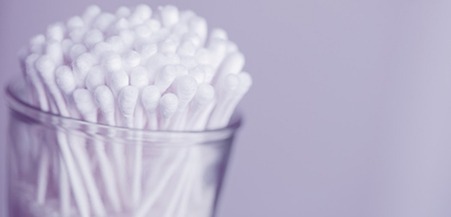
Regardless of the waste they produce, cotton swabs (Q-tips) are not recommended by doctors because of the risk of pushing the wax deeper into the ear and plugging them up. Stick to cleaning only the outer part of your ear. Simply cover your pinky finger with a thin handkerchief (see above) and gently wiggle out the wax.
This is most-effective after a warm shower as the heat will help soften the wax and make it easier to move. It’s important to remember, a build-up of earwax is good! Your body doing its job to lubricate your ear canals and prevent anything from entering. If you are really suffering from plugged up and waxy ears, go see a doctor!
11. Ditch the Loofah
Whenever I used a loofah, it did a better job falling apart rather than exfoliating. Ideally designed to scrub off the dead skin cells on our bodies, this can be a perfect opportunity for bacteria to cultivate and get caught in the nooks and crannies of the loofah. Every time it gets wet and does not dry properly, bacteria can grow. You are basically spreading yesterday’s dirt back onto your body. Gross!
If I attempted to wash my loofah, it ended up in me pulling pieces out of my washing machine. I found myself wastefully replacing my loofah far too often. Make the switch to extra-long exfoliating bath cloths. These do a fantastic job of exfoliating and are machine washable. They are extra large and long in the shape of a towel so you will have no problem getting to those hard to reach spots!
12. Upcycling Jars
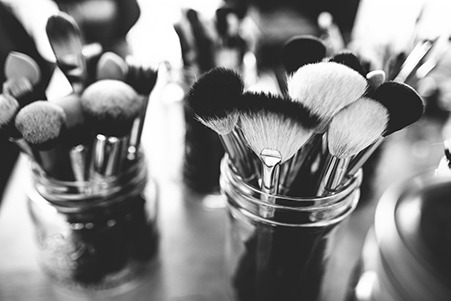
Instead of recycling your glass candle or mason jars, just upcycle them! Upcycling, also known as creative re-use, is the process of taking by-products or waste and turning it into something useful. Give a new purpose to your jars rather than just food storage in the kitchen.
My old glass candles serve as the perfect-sized vessels to place my makeup brushes in. Toothbrushes, cotton pads, razors, and soap: the possibilities are endless! Glass jars are the perfect way to keep your bathroom organized especially on a budget.
13. Use Recycled Toilet Paper
I am always conscious of my family’s toilet paper consumption. It is no secret that toilet paper can be incredibly wasteful. Each roll can be individually and excessively wrapped in plastic. Look to buy toilet paper that is 100% recycled or tree-free and comes wrapped in paper, not plastic. Be sure to compost the cardboard tube when finished.
14. Bidet or Spray
Transform your toilet like you’re in Europe! Another option is installing a spray nozzle or bidet attachment. Slightly expensive, but an investment. In the long run, using a bidet is WAY more sanitary for cleaning up after the deed and will drastically reduce your toilet paper consumption.
15. Avoid Excessive Packaging
I notice that many cosmetics and even toothpaste tubes come packaged with excess plastic or small cardboard boxes. Even the ones that promote an eco-friendly product! Stay clear of these if you wish to reduce your waste in the bathroom. Search for products that come with limited packaging which is compostable or biodegradable and are made from eco-friendly materials such as glass or metals.
16. Avoid Microbeads
Microbeads are extremely small pieces of plastic found in exfoliating agents, cleansing products, and even some toothpaste. Their purpose is to provide a grainy texture for exfoliation. A single bottle of facial scrub may contain as many as 300,000 microbeads and are present in many personal care products sold by companies such as Proctor and Gamble, L’Oreal, and Unilever. These tiny beads can cause damage to our waterways and are harmful when ingested by marine life.
You can avoid further water contamination by checking the ingredients of your favorite brand of exfoliating cleanser or personal care products. Stay clear of the following ingredients:
- Polyethylene (PE)
- Polypropylene (PP)
- Polyethylene terephthalate (PET)
- Polymethyl methacrylate (PMMA)
- Nylon (PA)
Fortunately today, there are dozens of brands available that produce all-natural and organic options for personal and skincare products.
17. Make Your Own Toiletries
If you want to go the extra mile to reduce your bathroom waste, consider making your own toiletries. Many synthetic shampoos and conditioners can be filled with toxic chemicals both harmful to our body and the environment. Below are some natural alternatives that can be simply mixed in the kitchen:
- Shampoo – mix 1 tablespoon (15ml) baking soda (sodium bicarbonate) and 1 cup (236ml) water together until the baking soda has fully dissolved and the water turns slightly cloudy. Apply the mixture to your hair focussing on your roots and working it in with your fingers and distributing throughout the rest of your hair. Rinse.
- Apple cider conditioner – mix 1 tablespoon (15ml) of apple cider vinegar with 1 cup (236ml) of water. Apply to your hair, working the mixture in as you did with the shampoo and rinse thoroughly.
Natural, nourishing, healthy ingredients are what make natural, nourished, healthy hair. There is an underground movement of people making the switch from synthetic hair products to all-natural ones, which is called the “no poo method”. This may take some getting used to as your hair may be extra oily to start, but many report healthier and fuller hair after a few months.
You can also find organic shampoo and conditioners in solid bar forms which will last much longer than traditional synthetic types. This also eliminates any excess plastic packaging that cannot be recycled.
18. Use Organic Soap
Skip out on the shrinkwrap and plastic dispensing pumps! Many commercial soaps will also contain toxic chemicals that wash down the drain and pollute the waterways and negatively affect marine life. Organic soaps are generally more expensive than commercial ones but they will also be healthier for our skin and deliver better results, without environmental consequences.
Look for a solid soap bar that is made from natural ingredients without any animal testing and comes with compostable packaging. Many organic soaps come in amazing-smelling fragrances!
19. Biodegradable Combs
Instead of tossing out a used up plastic comb or brush, make the switch to a biodegradable one. You can find combs and brushes which come in a variety of exotic woods or bamboo. They are all-natural, plastic-free, biodegradable and also very chic!
20. Dual Trash Cans
This simple addition to the corner of your bathroom will help you dispose of your used materials properly. Ideally, you will want two separate compartments, one for trash and the other for recyclables. Often times it’s so common for there to be a single “one-size-fits-all” trash can in the bathroom, completely ignoring the possibility of recycling.
21. Keep Track
One thing that really helped my family was keeping a tally of how much garbage was piling up in the bathroom trash can. With the addition of recycling bins available, we were able to limit our waste consumption down considerably. Set a goal for yourself and your family and keep it posted on the mirror or refrigerator. We found that is was a fun challenge for the whole family and a great opportunity to educate our kids on reducing waste.
Final Thoughts
You don’t have to be 100% all-natural and organic-obsessed like me for nearly every product in your bathroom. The most important thing is to reevaluate your daily routine and you will start to discover ways you can reduce and manage your waste in the bathroom. Many of our habits and routines are heavily ingrained within us and take some time to break. You will be pleasantly surprised with what you can do when you keep a conscious mind towards reducing your waste in the bathroom!
Related Questions
How can I save water in the bathroom? Save water by limiting your time in the shower or turning off the water when you brush your teeth or lather up. A more expensive option is to use a low-flow showerhead.
Is all plastic recyclable? There are many different types of plastics, not all of which can be recycled. PET (Polyethylene Terephthalate) is one of the most commonly used plastics found in water bottles and is fully recyclable. Be sure to check the recycling label to see if your plastic can be recycled.
Are cleaning chemicals harmful? Some cleaning products release volatile organic compounds (VOCs) which can cause eye, nose and throat irritation, headaches, nausea, and can also cause damage to the central nervous system. VOCs can be found in aerosol sprays, air fresheners, bleaches, detergent and dishwashing liquids among others.
